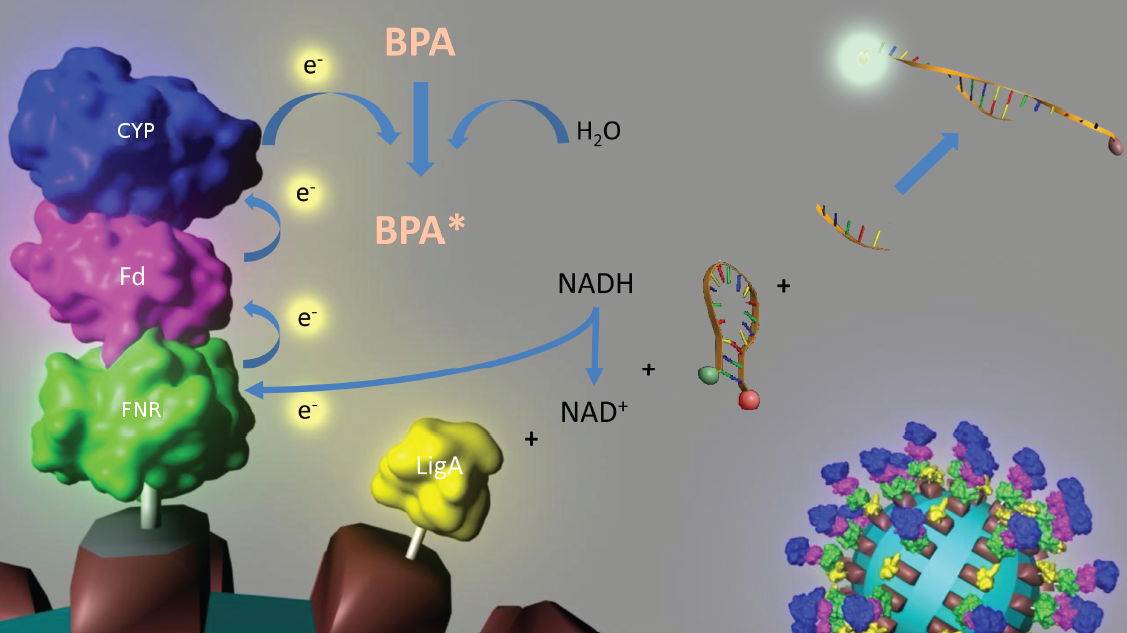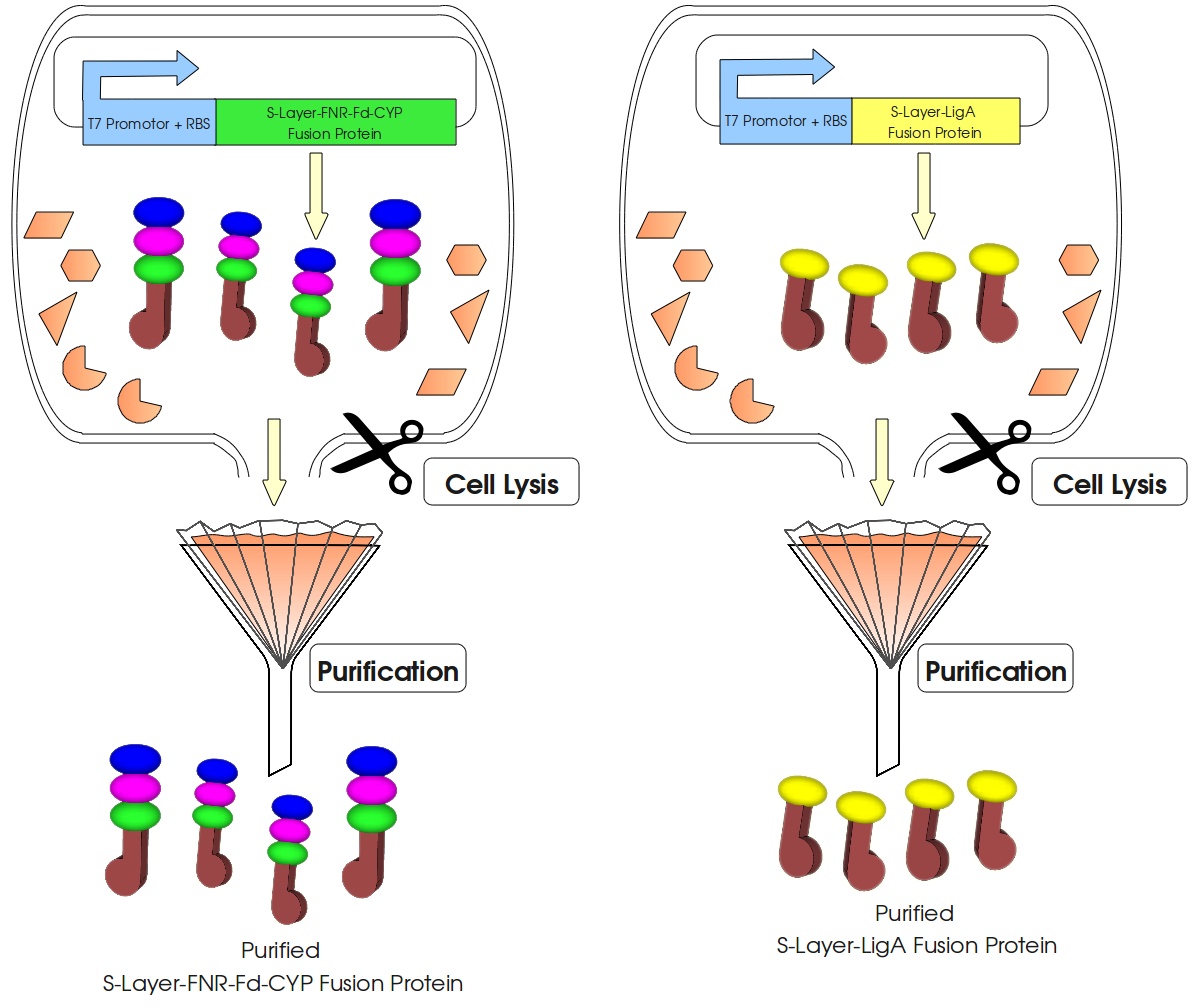Team:Bielefeld-Germany/Data Page
From 2011.igem.org
(Difference between revisions)
| Line 1: | Line 1: | ||
{{Bielefeld_2011_Header}} | {{Bielefeld_2011_Header}} | ||
| - | =How our System works= | + | This page gives a basic overview about our cellfree Bisphenol A biosensor system and the BioBricks we have used. A more detailed description of the biosensor system can be found in our [[Team:Bielefeld-Germany/Project/Description | project description]] and in the [[Team:Bielefeld-Germany/Project/Background/BPA | Bisphenol A]], [[Team:Bielefeld-Germany/Project/Background/S-Layer | S-Layer]] and [[Team:Bielefeld-Germany/Project/Background/NDA | NAD<sup>+</sup> detection]] background sections. |
| + | |||
| + | ==How our System works== | ||
[[Image:Bielefeld_2011_S-Layer-Produktion_lysis-purification_v1.jpg|center|700px|thumb|'''Fig. 1: Production of the S-Layer fusion proteins in E. coli.''' To build a cellfree Bisphenol A biosensor the S-Layer fusion proteins have to be extracted from the cells and purified (simplified schema).]] | [[Image:Bielefeld_2011_S-Layer-Produktion_lysis-purification_v1.jpg|center|700px|thumb|'''Fig. 1: Production of the S-Layer fusion proteins in E. coli.''' To build a cellfree Bisphenol A biosensor the S-Layer fusion proteins have to be extracted from the cells and purified (simplified schema).]] | ||
| Line 10: | Line 12: | ||
| - | =Data For Our Favorite New Parts= | + | ==Data For Our Favorite New Parts== |
# [http://partsregistry.org/Part:BBa_K525305 Main Page] - '''Fusion Protein of S-Layer SgsE and mCitrine''': This fluorescent S-layer fusion protein is used to characterize purification methods and to demonstrate the S-layer's ability to self-assemble on surfaces. | # [http://partsregistry.org/Part:BBa_K525305 Main Page] - '''Fusion Protein of S-Layer SgsE and mCitrine''': This fluorescent S-layer fusion protein is used to characterize purification methods and to demonstrate the S-layer's ability to self-assemble on surfaces. | ||
# [http://partsregistry.org/Part:BBa_K525517 Main Page] - '''Fusion Protein of BisdA and BisdB (expressed)''': This fusion protein improves the bisphenol A degradation in ''E. coli'' compared to the so far in the partsregistry existing BPA degrading BioBricks. | # [http://partsregistry.org/Part:BBa_K525517 Main Page] - '''Fusion Protein of BisdA and BisdB (expressed)''': This fusion protein improves the bisphenol A degradation in ''E. coli'' compared to the so far in the partsregistry existing BPA degrading BioBricks. | ||
| Line 16: | Line 18: | ||
| - | =Data For Pre-existing Parts= | + | ==Data For Pre-existing Parts== |
# [http://partsregistry.org/Part:BBa_K123000:Experience Experience] - '''BisdA degrades Bisphenol A when used with BisdB, BBa_K123000''' (University of Alberta, iGEM 2008): Complete degradation of 120 mg L<sup>-1</sup> Bisphenol A with polycistronic ''bisdAB'' gene in 30-33 h. Even faster (21-24 h) when using a fusion protein of BisdA and BisdB. | # [http://partsregistry.org/Part:BBa_K123000:Experience Experience] - '''BisdA degrades Bisphenol A when used with BisdB, BBa_K123000''' (University of Alberta, iGEM 2008): Complete degradation of 120 mg L<sup>-1</sup> Bisphenol A with polycistronic ''bisdAB'' gene in 30-33 h. Even faster (21-24 h) when using a fusion protein of BisdA and BisdB. | ||
# [http://partsregistry.org/Part:BBa_K123001:Experience Experience] - '''BisdB degrades Bisphenol A when used with BisdA, BBa_K123001''' (University of Alberta, iGEM 2008): Complete degradation of 120 mg L<sup>-1</sup> Bisphenol A with polycistronic ''bisdAB'' gene in 30-33 h. Even faster (21-24 h) when using a fusion protein of BisdA and BisdB. | # [http://partsregistry.org/Part:BBa_K123001:Experience Experience] - '''BisdB degrades Bisphenol A when used with BisdA, BBa_K123001''' (University of Alberta, iGEM 2008): Complete degradation of 120 mg L<sup>-1</sup> Bisphenol A with polycistronic ''bisdAB'' gene in 30-33 h. Even faster (21-24 h) when using a fusion protein of BisdA and BisdB. | ||
| Line 22: | Line 24: | ||
| - | =We've Also Characterized the Following Parts= | + | ==We've Also Characterized the Following Parts== |
# [http://partsregistry.org/Part:BBa_K525405 Main Page] - '''Fusion Protein of S-Layer SbpA and mCitrine''': This fluorescent S-layer fusion protein is used to characterize purification methods and to demonstrate the S-layer's ability to self-assemble on surfaces. | # [http://partsregistry.org/Part:BBa_K525405 Main Page] - '''Fusion Protein of S-Layer SbpA and mCitrine''': This fluorescent S-layer fusion protein is used to characterize purification methods and to demonstrate the S-layer's ability to self-assemble on surfaces. | ||
# [http://partsregistry.org/Part:BBa_K525512 Main Page] - '''Polycistronic expression of BisdA and BisdB''': This is the version of BPA degrading BioBricks found in the partsregistry - comparison to our fusion protein <partinfo>K525515</partinfo>. | # [http://partsregistry.org/Part:BBa_K525512 Main Page] - '''Polycistronic expression of BisdA and BisdB''': This is the version of BPA degrading BioBricks found in the partsregistry - comparison to our fusion protein <partinfo>K525515</partinfo>. | ||
Revision as of 18:11, 17 September 2011

This page gives a basic overview about our cellfree Bisphenol A biosensor system and the BioBricks we have used. A more detailed description of the biosensor system can be found in our project description and in the Bisphenol A, S-Layer and NAD+ detection background sections.
Contents |
How our System works

Fig. 3: Visualization of our cellfree Bisphenol A biosensor system with all essential components. Bisphenol A (BPA) is reduced by the electrons from NADH transfered by reductase (Red), ferredoxin (Fd) and cytochrome P450. The molecular beacon (hairpin structure) binds two short DNA-oligos. The NAD+ dependent ligase (LigA) ligates the two oligos so that the hairpin structure opens up and the fluorophore is able to emit light.
Data For Our Favorite New Parts
- [http://partsregistry.org/Part:BBa_K525305 Main Page] - Fusion Protein of S-Layer SgsE and mCitrine: This fluorescent S-layer fusion protein is used to characterize purification methods and to demonstrate the S-layer's ability to self-assemble on surfaces.
- [http://partsregistry.org/Part:BBa_K525517 Main Page] - Fusion Protein of BisdA and BisdB (expressed): This fusion protein improves the bisphenol A degradation in E. coli compared to the so far in the partsregistry existing BPA degrading BioBricks.
- [http://partsregistry.org/Part:BBa_K525710 Main Page] - NAD+-dependent DNA ligase from E. coli : This enzyme enables determination of NAD+ even in very low concentrations by coupling it with a molecular beacon based assay.
Data For Pre-existing Parts
- [http://partsregistry.org/Part:BBa_K123000:Experience Experience] - BisdA degrades Bisphenol A when used with BisdB, BBa_K123000 (University of Alberta, iGEM 2008): Complete degradation of 120 mg L-1 Bisphenol A with polycistronic bisdAB gene in 30-33 h. Even faster (21-24 h) when using a fusion protein of BisdA and BisdB.
- [http://partsregistry.org/Part:BBa_K123001:Experience Experience] - BisdB degrades Bisphenol A when used with BisdA, BBa_K123001 (University of Alberta, iGEM 2008): Complete degradation of 120 mg L-1 Bisphenol A with polycistronic bisdAB gene in 30-33 h. Even faster (21-24 h) when using a fusion protein of BisdA and BisdB.
We've Also Characterized the Following Parts
- [http://partsregistry.org/Part:BBa_K525405 Main Page] - Fusion Protein of S-Layer SbpA and mCitrine: This fluorescent S-layer fusion protein is used to characterize purification methods and to demonstrate the S-layer's ability to self-assemble on surfaces.
- [http://partsregistry.org/Part:BBa_K525512 Main Page] - Polycistronic expression of BisdA and BisdB: This is the version of BPA degrading BioBricks found in the partsregistry - comparison to our fusion protein <partinfo>K525515</partinfo>.
 "
"


